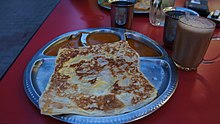Mamak stall

Mamak stalls are open-air food establishments particularly found in Southeast Asia, especially Malaysia and Singapore, which serve a type of Indian Muslim cuisine unique to the region.
History[]

The Malaysian Mamak are Malaysians of Tamil Muslim origin, whose forefathers mostly migrated from South India to the Malay Peninsula and various locations in Southeast Asia centuries ago. They are regarded as part of the Malaysian Indian community. Archaeological findings in Bujang Valley, Kedah, Malaysia suggest a trade relationship with India as early as the 1st to 5th century C.E.[1][2] An inscription dated 779 AD that refers to the trade relationship between the Tamil country and Malaya has been found in Ligor, Malay Peninsula.[3]
The word 'Mamak' is from the Tamil term for maternal uncle, or 'maa-ma'. In Singapore and Malaysia, it is used by children as an honorific to respectfully address adults such as shopkeepers. Although the origins of the word are benign, it is sometimes used as a derogatory term[4] for the Indian Muslim community in Malaysia.[by whom?]
Mamak stalls and Hindu stalls are alike except the Mamaks, who are Muslims, do not serve pork but serve beef, whereas Hindus serve neither beef nor pork. There are also similar stalls run by local Malays.
Design[]

Mamak stalls' affordable food and unpretentious atmosphere tend to create a casual dining atmosphere. Newer mamak stalls have more of a café aspect, usually being well lit and furnished with stainless steel tables. Some are outfitted with large flat screen televisions, or even projectors, so that patrons can catch the latest programs or live matches as they dine. Some mamak stalls also provide free Wi-Fi service. Despite these innovations, many modern mamak stalls attempt to retain their predecessors' open air dining atmosphere by setting up tables on a patio, the shoplot's walkway, or even on the street.
Mamak Fare[]


A mamak stall usually offers different varieties of roti canai to eat and teh tarik, coffee, Milo, Horlicks and soft drinks to drink. Most mamak stalls also serve several varieties of rice, such as nasi lemak and nasi goreng, as well as noodle dishes such as mee goreng (fried noodles). Some stalls also offer satay and Western dishes.
A typical Mamak stall will offer the following dishes, though this differs from stall to stall:
- Roti canai
- Roti Telur
- Teh tarik (literally 'Pulled Tea')
- Half-boiled eggs
- Goat's milk
- Murtabak
- Thosai
- Chapati
- Nasi kandar
- Nasi briyani
- Nasi lemak
- Maggi goreng (fried Maggi noodles)
- Mi goreng (fried yellow noodles)
- Mi rebus (egg noodles dish)
- Indomie Mi goreng
- Pasembur
- Mamak Rojak
- Sup Kambing (goat soup)
- Sup Ayam (chicken soup)
- Sup Tulang
- Roti Tissue
- Roti Bakar
- Roti Boom
- Roti naan with tandoori chicken
- Puri or Poori
Malay Tom Yam Stall[]
Recently, to attract more customers, some Mamak restaurants have added an extra stall in their restaurant. The stall, which is operated individually by either an ethnic Malay from the North East Peninsular Malaysia or an ethnic Malay from Southern Thailand, is known as Malay tom yam stall. This provides customers with more food options, such as:
- Tom yam
- Nasi paprik
- Nasi goreng Kampung (village fried rice)
- Nasi goreng Cina (Chinese fried rice)
- Nasi goreng USA (Fried rice with prawn(Udang), squid(Sotong) and chicken(Ayam) )
- Nasi masak merah (cooked red rice)
- Nasi pattaya (Pattaya style fried rice)
- Telur bistik
- Sayur campur (mixed vegetables)
- Ikan pedas (spicy fish)
- Nasi lala (clam rice)
Tom yam stalls first appeared in Peninsular Malaysia circa late 1970s and early 1980s. Unlike local Malay food, the food is basically Thai based and somewhat similar to the cuisine in the state of Kelantan. The tom yam dishes have a mix of typically sweet, hot, and sour flavours. As the dishes are cooked immediately upon the customer's order, tom yam stalls are the Malay equivalent of fast food outlets albeit with Thai-based cuisine.
Tom yam stalls can also be found by the street or at designated areas such as car parks at night. These stalls tend to be popular. Many tom yam stalls are built illegally, usually on land reserved for public roads. Attempts to remove these illegal stalls have been fairly successful[citation needed] but such attempts can have a political price.
See also[]
References[]
- ^ THE ANCIENT IRON SMELTING IN SG. BATU, BUJANG VALLEY, KEDAH
- ^ EurASEAA Dublin 2012, 14th International Conference
- ^ Arokiaswamy, Celine W.M. (2000). Tamil Influences in Malaysia, Indonesia, and the Philippines. Manila s.n. pp. 37, 38, 41, 43, 45–49, 51–57.
- ^ "The Merchants of Penang | The Star". www.thestar.com.my. Retrieved 4 April 2021.
External links[]
- Malaysian Food
- The 'Mamak Stall' Culture
- Mamak-ing, A Malaysian word for tourists to get acquainted to
- Malaysian cuisine
- Restaurants in Malaysia
- Malaysian culture
- Types of coffeehouses
- Restaurants by type